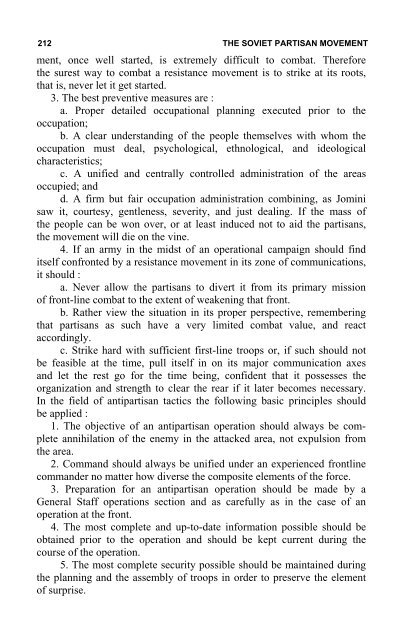the soviet partisan movement 1941-1944 by edgar m. howell
the soviet partisan movement 1941-1944 by edgar m. howell
the soviet partisan movement 1941-1944 by edgar m. howell
Create successful ePaper yourself
Turn your PDF publications into a flip-book with our unique Google optimized e-Paper software.
212 THE SOVIET PARTISAN MOVEMENT<br />
ment, once well started, is extremely difficult to combat. Therefore<br />
<strong>the</strong> surest way to combat a resistance <strong>movement</strong> is to strike at its roots,<br />
that is, never let it get started.<br />
3. The best preventive measures are :<br />
a. Proper detailed occupational planning executed prior to <strong>the</strong><br />
occupation;<br />
b. A clear understanding of <strong>the</strong> people <strong>the</strong>mselves with whom <strong>the</strong><br />
occupation must deal, psychological, ethnological, and ideological<br />
characteristics;<br />
c. A unified and centrally controlled administration of <strong>the</strong> areas<br />
occupied; and<br />
d. A firm but fair occupation administration combining, as Jomini<br />
saw it, courtesy, gentleness, severity, and just dealing. If <strong>the</strong> mass of<br />
<strong>the</strong> people can be won over, or at least induced not to aid <strong>the</strong> <strong>partisan</strong>s,<br />
<strong>the</strong> <strong>movement</strong> will die on <strong>the</strong> vine.<br />
4. If an army in <strong>the</strong> midst of an operational campaign should find<br />
itself confronted <strong>by</strong> a resistance <strong>movement</strong> in its zone of communications,<br />
it should :<br />
a. Never allow <strong>the</strong> <strong>partisan</strong>s to divert it from its primary mission<br />
of front-line combat to <strong>the</strong> extent of weakening that front.<br />
b. Ra<strong>the</strong>r view <strong>the</strong> situation in its proper perspective, remembering<br />
that <strong>partisan</strong>s as such have a very limited combat value, and react<br />
accordingly.<br />
c. Strike hard with sufficient first-line troops or, if such should not<br />
be feasible at <strong>the</strong> time, pull itself in on its major communication axes<br />
and let <strong>the</strong> rest go for <strong>the</strong> time being, confident that it possesses <strong>the</strong><br />
organization and strength to clear <strong>the</strong> rear if it later becomes necessary.<br />
In <strong>the</strong> field of anti<strong>partisan</strong> tactics <strong>the</strong> following basic principles should<br />
be applied :<br />
1. The objective of an anti<strong>partisan</strong> operation should always be complete<br />
annihilation of <strong>the</strong> enemy in <strong>the</strong> attacked area, not expulsion from<br />
<strong>the</strong> area.<br />
2. Command should always be unified under an experienced frontline<br />
commander no matter how diverse <strong>the</strong> composite elements of <strong>the</strong> force.<br />
3. Preparation for an anti<strong>partisan</strong> operation should be made <strong>by</strong> a<br />
General Staff operations section and as carefully as in <strong>the</strong> case of an<br />
operation at <strong>the</strong> front.<br />
4. The most complete and up-to-date information possible should be<br />
obtained prior to <strong>the</strong> operation and should be kept current during <strong>the</strong><br />
course of <strong>the</strong> operation.<br />
5. The most complete security possible should be maintained during<br />
<strong>the</strong> planning and <strong>the</strong> assembly of troops in order to preserve <strong>the</strong> element<br />
of surprise.
















